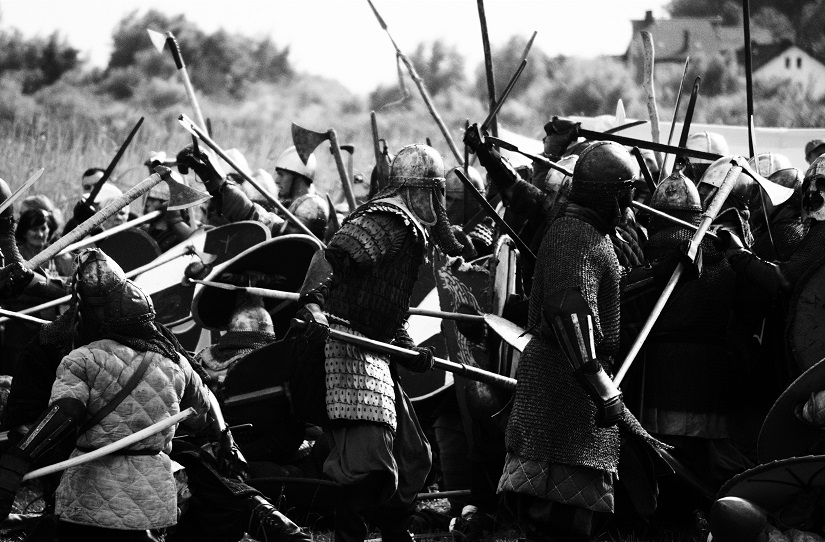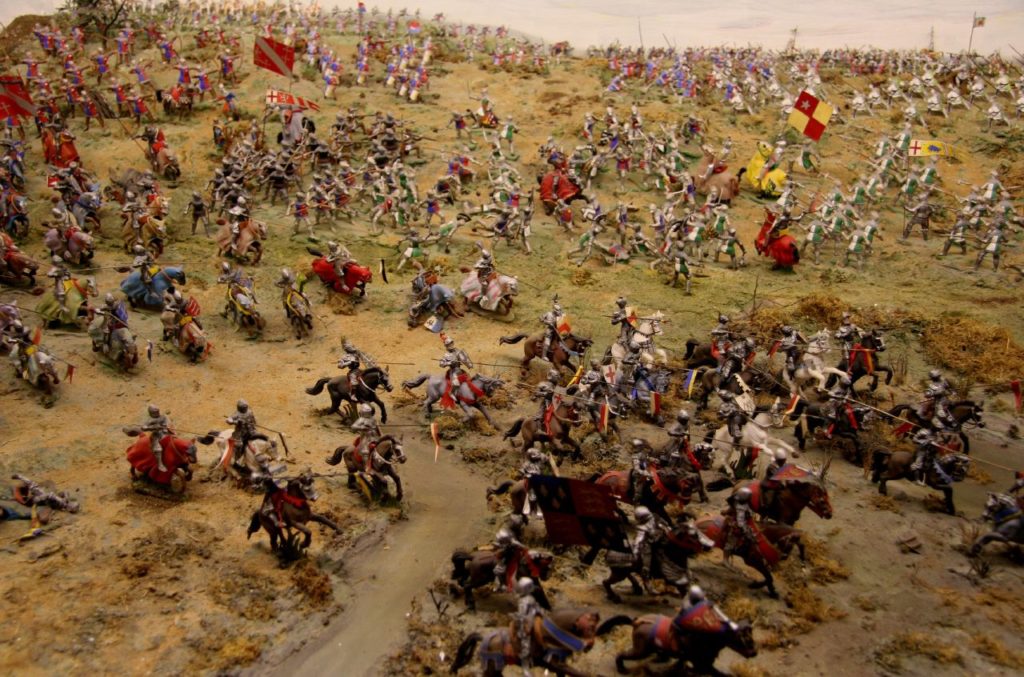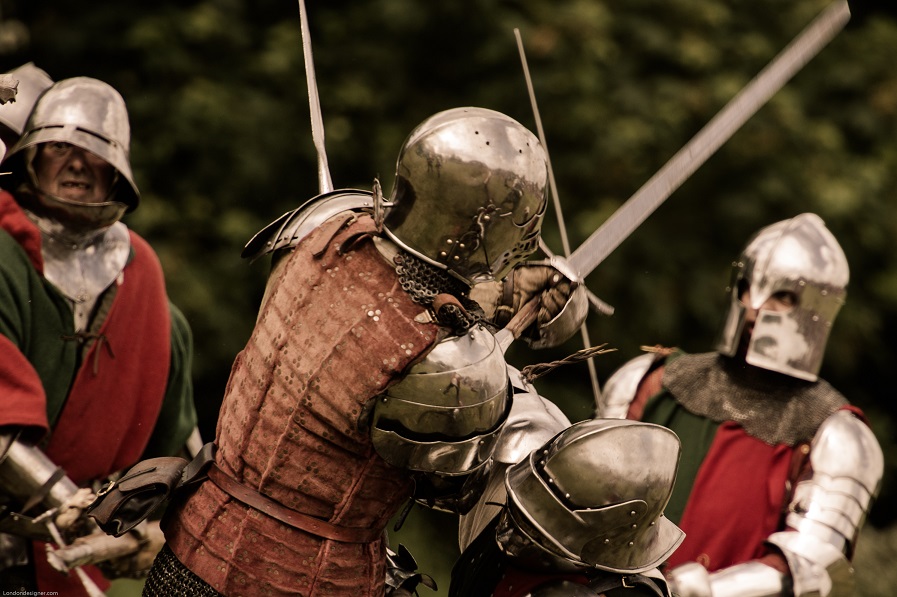
12 Mar GMing Lessons #9: Running Epic Battles
When you first think of running large-scale combats, even battles, you may find the prospect seems exciting at first… and then you start to think about the inevitable grind of it all… how it’s just going to drag on, and on, and on…
I mean, when you look at it, a “short” skirmish between a few pc’s and a couple of dozen powerful baddies can take an entire game session in itself with many games! So how long would an entire battle take to play out? Days? Weeks? Would you ever leave the gaming room?
It would also be exceptionally boring. Whereas in most combats, you’re hanging on every sword blow and each bullet that whines past your face, in battles the bullets and swords and general smashing-killing-dying is happening so much that people end up zoning out. They become mechanical. They swing and chop for hours until they can barely move their arms.
So what’s the solution? Should you just give up massed combats altogether?
Hell no. Battles are epic, and as characters get into the higher levels of awesomeness, it makes it really cool that they can not only direct or influence battles, but actively engage in them and make the difference.
That last part is the most crucial thing. It makes the difference. They want to feel like what they did influenced the battle. Maybe didn’t win it, depending on how well they did – but what if their actions did win the battle?! Woah, that would be quite a high.
Okay, so here’s how I run this, after much trial and error.

Doesn’t that look epic? Why limit yourself? Put epic battles into your games and your gamers will probably thank you (or die in a bloody puddle… that can happen too).
1) Roll a Few Times
When they’re in a grind, in the press of battle, hacking away at dudes and trying to stay alive, or shooting over a trench at massed gribblies wave-charging them up a slope, it does no good trying to break things down to rounds, to rolling for initiative, or even rolling to strike and damage. Negative. That’s boring. In reality, you need to move swiftly on to the next major crisis point of the battle.
So in these instances, have them roll a few times. You could roll 3-5 times (I usually just roll 3 times). For me, I get them to roll their combat bonus, and then roll against them to see if there’s any peril coming back at them. Depending on how intense the game is, if they fail on the roll they may just take damage there and then (if they have stacks of HP), or in a gritty game, where a single blow could kill them, it now brings you to a great crisis point – a moment where they could get killed. Now you should play this out.
Rolling a few times shows you very rapidly how they’re doing in the combat. Are they hacking down their opponents, spraying themselves in their gore? Are they picking them off left and right? Make some epic descriptions for them, but keep it within the realms of their rolls. And remember – combat is unpredictable and terrifying at the best of times, they’re knocked and smashed, artillery rounds come in… you get the idea. Make it horrifying.
2) Roll For The Different Sides
You can also roll for the different sides of the combat. Roll for how they’re doing right now. One or a few rolls each, with a bonus assigned to each side, depending on what you think should influence it – i.e., do they have the high ground, do they outnumber their opponents, are they better trained and equipped?
Characters can greatly influence how this combat goes by using their command and control skills. In Immersion RPG there’s a “Command” skill and a “Military” skill. I really like the last one, because it allows you to simulate your ability to control tactics, men, situations and timing. There’s a “battle sense” that good commanders have – and this is it! Any game could find a few skills that work – the players’ rolls should influence the rolls of each side, so long as they are actively Roleplaying what they’re doing to be so effective (being in the front lines is often detrimental to this – though if they do well there, that can also influence it in other ways… by killing heroes, and other crisis points).
2) Crisis Points
This sounds like the name of a video game, but it’s not.
Actually, this is basically what a battle boils down to. You can plan these out, or you can do what I do and just let it flow. I personally like to just let it flow, because that brings so much more variability into the equation. You can’t possibly plan for the player Bungling his Strike roll against goblins, and getting swarmed by a pack of the runts!
Basically, Crisis Points are what the battle is all about. These are the moments of intense interest that mean the players have come up against a champion, or several champions. The players are in a life-and-death struggle moment, or they’ve seen the weak point in the enemy lines, and have decided to charge it. Or they’ve found the sorcerers who’ve been bombarding their lines, and now they need to break through the hard-core troops defending them… and get through all their spells too.
Crisis Points often mean you should now roll for Initiative, and run out a combat within the major battle. This might mean it gets interrupted by other people charging in just before they can finish the dispute, or by bombs going off, or whatever. You can roll for that stuff, or do what’s fun, up to you.
I usually brush through the other parts, make it intense, make sure the players know what’s going on (and allow them to implement strategy), and then jump into the crisis point, which is sometimes simply something initiated by their rolls, but more often them making some critical assault/defence of a key area. This then affects the rest of the battle.
You should, obviously, make this as intense and vivid and organic as possible. I stress the last one because you don’t want to make it seem like, “this is the boss part” or “this is now the part where you save the day.” Rather, I find it much more impactful when you give them total freedom to decide what they’re going to do.
You’re going to lead a desperate charge towards their leader? Okay, that may work. Roll the dice, see whether the leader is in a good or bad position (could have opposing Military rolls or something like that depending on what game you play).
I think you get the idea. You can be as specific or as fluid as you like. I usually find that being specific with the tactics and situations is good, and then being fluid with the long battles is fun, followed up with specific points of detail in the crisis points and that sort of thing.
Play with it, have fun – and hey, tell me how it goes! You can always swing me an email at oliver at immersion-rpg dot com
Good gaming!
Oliver R. Shead
_______________________________________
P.S. If you would like to check out my latest setting, Infected! a brutally realistic vision of the zombie apocalypse, I won’t be mad. Check it out here.
Making the Best Infected Campaign Ever
How to Run the Most Epic Combats Ever



jay murphy
Posted at 13:44h, 18 MarchGood points.
Oliver R. Shead
Posted at 20:21h, 18 MarchHey Jay,
Cheers mate 🙂
Best,
Oliver